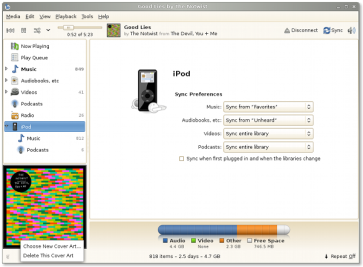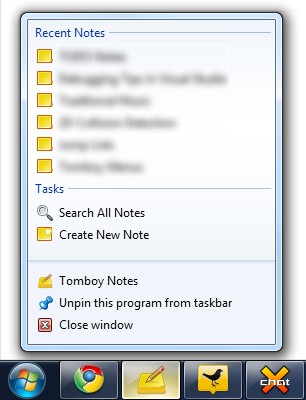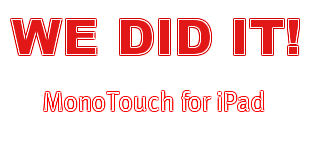iPad - Inspirational Hardware
iPad - Inspirational Hardware
As a software developer, I find the iPad inspirational.
Apple's iPad is not a new idea. They are not the first ones to think of a tablet and as many blogs have pointed out the Apple iPad is not everyone's dream machine, the hardware is lacking gadgets and the software is not that amazing.
Five elements come together to revolutionize software:
- Price
- Multi-touch centric development
- Standard hardware available for consumers
- Apple's AppStore
- Large form factor.
The iPhoneOS is a multi-touch centric operating system. For years application developers have been subjected to the tyranny of the mouse and keyboard. This has been the only input technology that developers could reliably depend on and expect to be available on the user's system. Any software that requires different input mechanism sees its potential market reduced.
The mouse is a great device for certain class of desktop applications. But it has also led to applications that are incredibly frustrating to use. Software for editing music and audio is cumbersome. Find the target, drag it, move it, find the other button, click it, scroll, drag, click. Anyone that has used Garage Band to try to play along knows this. The same applies to software to paint or draw. The mouse and keyboard are poor substitutes for using your hands.
On the iPhone, and now the iPad, the situation is reversed. Multi-touch is the only input mechanism that developers can depend on. Apple's iPhone helped create a community of developers that think in terms of taps, pinches and twirls instead of clicks, double-clicks and right-clicks. It is no longer an after thought. It is no longer a feature that is added if there is enough time in the schedule or enough budget. It is the only option available.
Taps, pinches and twirls allow us to use the full expression of our hands to drive an application. And it is not just any multi-touch, it is multi-touch over the same surface where the application is providing feedback to the user. Software that respond to user input in the same way that a physical object responds to our physical contact is the key to create new user experiences.
This is a whole new space in which we can research, a new space that we can explore and where we can create a whole new class of computer/user interactions. With the new form factor, we can now create applications that just made no sense on the iPhone.
It is fascinating.
The standardized hardware means that software developers do not have face testing their software with dozens of combinatorial options. There are only a handful types of systems. If the software works on the core systems, they will work on all consumer devices. Standardized hardware is at the core of the success of the console gaming market, developers test and develop against a uniform platform. Price is the cherry on top of the cake, this device will be mass produced and the affordable price means that it will have a deep reach.
The possibilities for new computer/user interactions are no longer dampened by this market reality. As developers, a new door to invention and innovation has been opened for us. No longer will software developers have to cripple their user experiences based on the mouse and keyboard.
For the past couple of years I have had some ideas for some software that I wanted to build on a touch-based computer, but the specter of having a small user base for my experiments always discouraged me. Ever since I heard the rumors about Apple producing a tablet computer I have not cared about what the device looked like, or what the software stack for it was going to be. I wanted to try new touch-based UI ideas, I have dozens of ideas that I want to try out. And with Mono, I get to do it in my favorite language.
Posted on 29 Jan 2010
Release-o-Rama
Nice new releases of software that I use in the last few days.

Banshee 1.5
A new Banshee release, now supports new device syncing options, audiobooks, eMusic and GIO for non-local files. Gabriel has more details as well.
Now with a fully self-contained Mono and Gtk+ stacks on OSX. On the OSX note, I recommend Michael Hutchinson's blog entries on how to package your Gtk# app for use in OSX as well as his article on how to make your Gtk# app integrate with OSX. Both based on the lessons of bringing MonoDevelop and MonoDoc to OSX.
Jeroen Frijters released his IKVM.Reflection API. His API could be very useful for Reflection-Emit compiler writers, perhaps we could even use it in Mono's C# compiler to solve our long standing issues with Reflection. More research is needed on this area.
Maurits Rijk has published a new version of GIMP# his Mono-based plugin engine that lets you write plugins in any Mono supported language. There are samples in C# 3, F#, Boo, Nemerle, Oxygene, IronPython, Java/IKVM and Visual Basic.

Sandy released a new version of Tomboy, now supports exporting data in HTML format to the clipboard and jump Lists on Windows 7.
Posted on 28 Jan 2010
iPad Support for MonoTouch!

24 hours after we got the iPad SDK we completed the support for the iPad for MonoTouch!
To get started with iPad development, go to http://monotouch.net/iPad and follow the instructions.
Let the iPad# hacking begin!
Posted on 28 Jan 2010
24 hour race
Another Mono-race, in 24 hours we are aiming to:
- Support the iPad SDK from Apple (freshly baked and published).
- Add MonoDevelop support for it.
Posted on 27 Jan 2010
Preordering the Apple Tablet

Posted on 25 Jan 2010
MVP Award
Thanks to everyone that participated in the campaign to nominate me for a C# MVP award, when I got back to Boston I found on my piles of email that I am now part of the program.
This is Pretty Sweet(tm). This will be a great opportunity to build more bridges with Windows developers and show them that there is an ECMA CLI life in the other side of the OS spectrum.
Looking forward to the group picture!
Posted on 11 Jan 2010
Mono at FOSDEM
This year we will have a Mono Room at the FOSDEM Conference in Brussels. The FOSDEM conference is held on the weekend on February 6th and 7th.
Ruben and Stephane organized the room and the speakers for the it. has posted the finalized schedule for the Mono activities at FOSDEM on Sunday.
Here is the schedule, there are some pretty interesting talks:
| 09:00 - 09:15 | Opening (Ruben Vermeersch, Stéphane Delcroix) |
| 09:15 - 10:00 | MonoDevelop (Lluis Sanchez Gual) |
| 10:00 - 11:00 | The Ruby and .NET love child (Ivan Porto Carrero) |
| 11:00 - 12:00 | Mono Edge (Miguel de Icaza) |
Lunch Break | |
| 12:45 - 13:15 | The evolution of MonoTorrent (Alan McGovern) |
| 13:15 - 13:45 | Image processing with Mono.Simd (Stéphane Delcroix) |
| 13:45 - 14:15 | ParallelFx, bringing Mono applications in the multicore era (Jérémie Laval) |
Coffee Break | |
| 14:30 - 15:30 | Building The Virtual Babel: Mono In Second Life (Jim Purbrick) |
| 15:30 - 16:00 | Moonlight and you (Andreia Gaita) |
| 16:00 - 16:30 | OSCTool - learning C# and Mono by doing (Jo Shields) |
| 16:30 - 16:45 | Smuxi - IRC in a modern environment (Mirco Bauer) |
| 16:45 - 17:00 | Closing (Ruben Vermeersch, Stéphane Delcroix) |
Posted on 11 Jan 2010
Pixel Shaders for Moonlight
David Reveman has just posted a fascinating patch that debuts the support of pixel shaders in Moonlight.
David's patch uses Gallium, and he says:
The current implementation uses gallium's softpipe driver but hooking up the llvm driver as well should be a minor task and give significantly better software performance.[...]
My current approach is to focus on getting all these things working in software first. By using a OpenVG backend for cairo we can incrementally move to using gallium and hardware for all rendering.
Posted on 07 Jan 2010
Moonlight: Platform Abstraction Layer Lands
Chris Toshok has landed the changes necessary to abstract Moonlight's engine from the platform.
The platform abstraction layer lives in moon/src/pal and the Gtk+ interface lives in moon/src/pal/gtk.
This is a necessary step to bring Moonlight to non-X11 powered GUI systems.
Posted on 06 Jan 2010
Blog Search
Archive
- 2024
Apr Jun - 2020
Mar Aug Sep - 2018
Jan Feb Apr May Dec - 2016
Jan Feb Jul Sep - 2014
Jan Apr May Jul Aug Sep Oct Nov Dec - 2012
Feb Mar Apr Aug Sep Oct Nov - 2010
Jan Feb Mar Apr May Jun Jul Aug Sep Oct Nov Dec - 2008
Jan Feb Mar Apr May Jun Jul Aug Sep Oct Nov Dec - 2006
Jan Feb Mar Apr May Jun Jul Aug Sep Oct Nov Dec - 2004
Jan Feb Mar Apr May Jun Jul Aug Sep Oct Nov Dec - 2002
Jan Feb Mar Apr May Jun Jul Aug Sep Oct Dec
- 2022
Apr - 2019
Mar Apr - 2017
Jan Nov Dec - 2015
Jan Jul Aug Sep Oct Dec - 2013
Feb Mar Apr Jun Aug Oct - 2011
Jan Feb Mar Apr May Jun Jul Aug Sep Oct Nov Dec - 2009
Jan Feb Mar Apr May Jun Jul Aug Sep Oct Nov Dec - 2007
Jan Feb Mar Apr May Jun Jul Aug Sep Oct Nov Dec - 2005
Jan Feb Mar Apr May Jun Jul Aug Sep Oct Nov Dec - 2003
Jan Feb Mar Apr Jun Jul Aug Sep Oct Nov Dec - 2001
Apr May Jun Jul Aug Sep Oct Nov Dec